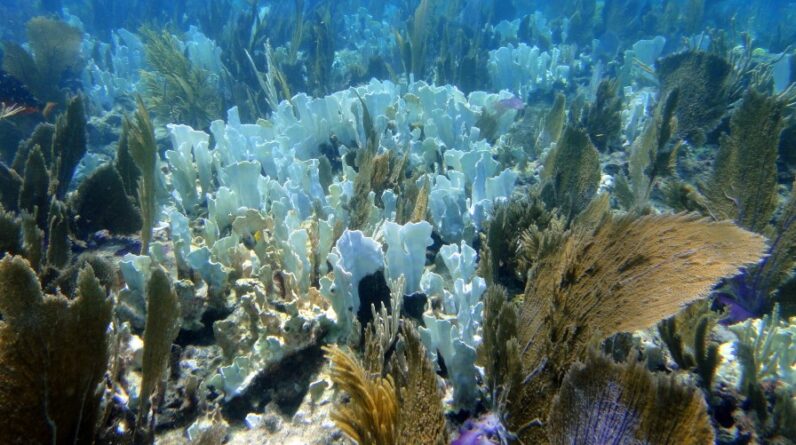
[ad_1]
Bleached Millepora at Molasses Reef, Florida. Image taken on September 17, 2014 during a coral bleaching event.
Credit – Matt Kieffer, CC SA 2.0.
Coastal waters around Florida have reached alarming temperatures of 95 degrees Fahrenheit (35 degrees Celsius).
The state of Florida is experiencing the hottest year in modern history, with temperatures over land averaging in the mid-90s F (35 C). The ocean near the coast has absorbed much of this heat, causing sea temperatures to soar to record highs.
With water temperatures surging into the mid-to-upper 90s in the Florida Keys over the past few days. not only is this a concern because the heat will strengthen storms and hurricanes, but it will spell trouble for marine ecosystems, according to ClickOrlando.com.
“It’s an astounding, prolonged heat wave even for a place that’s no stranger to sultry weather,” Brian McNoldy, a senior research associate at the University of Miami’s School of Marine, Atmospheric, and Earth Science, told the Washington Post.
“It’s not something we like to see near land simply because it would allow a storm to maintain a high intensity right up to landfall or rapidly intensify as it approaches landfall.”
 Record-high sea surface temperatures may trigger catastrophic coral bleaching along the coast of Florida. (Image credit: NOAA Coral Reef Watch)
Record-high sea surface temperatures may trigger catastrophic coral bleaching along the coast of Florida. (Image credit: NOAA Coral Reef Watch)
One very big concern is the threat of severe coral bleaching. Extreme ocean heat and its duration are critical in deciding the survival of coral reefs. Temperatures that are too hot for too long cause coral to bleach, turning a ghastly white as they expel their algal food source and slowly starve to death.
Should this happen, the effects would be far-reaching. Normally, coral polyps live in an endosymbiotic relationship with zooxanthellae. The coral provides the zooxanthellae with shelter. In return, the zooxanthellae provide compounds that give energy to the coral through photosynthesis.
This symbiotic relationship has allowed coral to survive for at least 210 million years in nutrient-poor environments. Coral bleaching is caused by the breakdown of this relationship.
All it takes is sea surface warming of 1 degree Celsius, or 2 to 3 degrees Fahrenheit, beyond the reef’s normal highest temperature to trigger the heat stress that leads to bleaching, according to Derek Manzello, a coordinator at the National Oceanic and Atmospheric Administration’s Coral Reef Watch, reports CNN.
“The sea surface temperatures around Florida are more than 2 degrees Celsius above that normal range and have been for one to two weeks,” he said.
 Christmas tree worms (Spirobranchus giganteus) on a bleached coral head, French Reef, Key Largo, Florida on September 19, 2014. (Credit – Matt Kieffer, CC SA 2.0).
Christmas tree worms (Spirobranchus giganteus) on a bleached coral head, French Reef, Key Largo, Florida on September 19, 2014. (Credit – Matt Kieffer, CC SA 2.0).
Ocean temperatures around Florida usually get hotter as the summer progresses and don’t reach their peak until late August into September, Manzello said, meaning ocean temperatures could rise further.
That would mean “significant and severe” bleaching will start in the next week and the coral could start to die altogether within a month, he said.
“It still remains to be seen if this event is going to be more or less severe than previous events,” Manzello said. “However, all of the evidence right now is pointing to the fact that it’s going to be one of the more severe events we’ve seen.”
“Thus, we are a full month ahead of what is the normal ‘bleaching season.’ What this means is, unless significant cooling takes place, such as repeat passage of hurricanes or tropical storms, the corals of the Florida Keys may be looking at upwards of three consecutive months of thermally-stressful conditions, which would be unprecedented,” said Manzello.
[ad_2]
Source link






